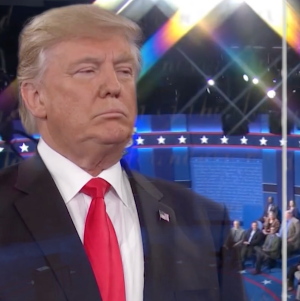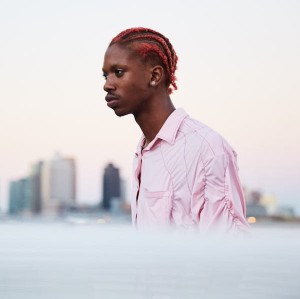Guided Meditation Sam Lavigne In Sam Lavigne’s video work, the 2016 Presidential election debate becomes a guided meditation performed by the candidates; a process of renewal and self-healing for the nation. “Umms” become “omms” and political jargon a meditative mantra. Sam Lavigne is an artist and programmer based in Brooklyn whose work deals with surveillance, cops, data, and automation. He is currently in residence at Pioneer Works, and a contributing editor at The New Inquiry.… [read more »]

MT RUSH Two Scenes from a new film by Elizabeth Orr Elizabeth Orr’s film, MT RUSH, is a near-future science fiction video chronicling the day-to-day activities of a female Mt. Rushmore Park Ranger as she navigates an onslaught of interactive fundraising emails that appear on a transparent interface. The narrative arc of the movie is based on the urgent, alarmist, and oddly personalized campaign and fundraising emails from the Democrats and Republicans (i.e. Hillary Has… [read more »]
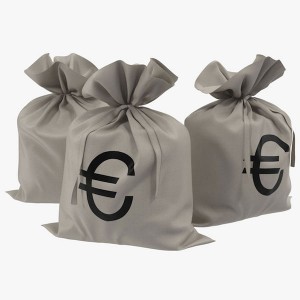
Lottery Party Ingo Niermann In Germany’s parliamentary democracy, every eligible citizen gets two votes: one for a candidate to represent their district and another for the party of their choice to hold additional seats in national Parliament. The relative ease of founding a political party and the mere five percent of votes required for gaining national representation has lead to a pool of over fifty parties fielding candidates during elections. Still, many voters struggle to… [read more »]
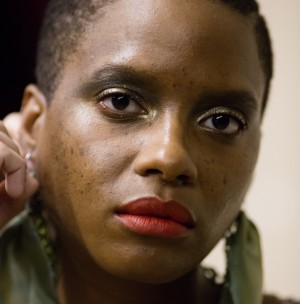
Courtesy Oto Gillen Courtesy Oto Gillen Courtesy Oto Gillen Courtesy Oto Gillen Courtesy Oto Gillen Courtesy Oto Gillen Courtesy Oto Gillen Courtesy Oto Gillen Courtesy Oto Gillen Courtesy Oto Gillen Courtesy Oto Gillen Courtesy Oto Gillen Courtesy Oto Gillen Courtesy Bogdan Teslar Kwiatkowski Courtesy Bogdan Teslar Kwiatkowski Courtesy Bogdan Teslar Kwiatkowski Courtesy Bogdan Teslar Kwiatkowski Courtesy Bogdan Teslar Kwiatkowski Courtesy Bogdan Teslar Kwiatkowski Courtesy Bogdan Teslar Kwiatkowski Courtesy Bogdan Teslar Kwiatkowski Courtesy Bogdan Teslar Kwiatkowski… [read more »]

Swarovski Crystal Meth, a collaboration between Ser Serpas, Daniela Czenstochowski and Gia Garrison for the National Sawdust “Selkie Series” performances, curated by Alexandra Marzella. Music composed and produced by Daniela Czenstochowski Poem by Sera Serpas Sound Edit Mateo Majluf Vocals Sera Serpas, Gia Garrison and Daniela Czenstochowski All Images Olimpia Dior i went to the desert con mi mama outlet store shopping is fried onto mi conciensa, big bags, wins bigger losses fragmented lux economy… [read more »]

Shop items from the most recent Hasbeens and Willbees luxury auction now! Featuring Bjarne Melgaard, Bror August, Women’s History Museum, Lou Dallas, Hermes, Gautier, and more. All photography Dillon Sachs Styling Avena Gallagher Hosted by Rome Gallery NYC

What is a piece of clothing that “works”? Who is working whom? Is the one who poses the one who actually “works” hardest? The S/S 2017 collection of Berlin-based, Swedish- Vietnamese designer NHU DUONG entitled ‘WORK COLLECTION’ plays with the ideas of professionalism, leisure and appropriateness through a range of garments that are inspired by work outfits and hobby uniforms. Overalls, raw denim outfits, kung-fu pyjamas, biker pants, baggy tights and gloves, bomber-jackets, bomber suits,… [read more »]
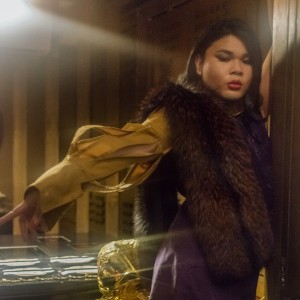
Miss DeSe Iron Chef What is taste…what is glam? What does glam taste like? How do you know when something is glam….or not? A New York Fashionista, artist, Dj and chef, Miss DeSe is here today to explore the heights of fashion that only an NYC hot pot can achieve. DeSe has always had a fantasy. That all food would look as glam as she does. So she built 99 favors with her formidable inheritance… [read more »]
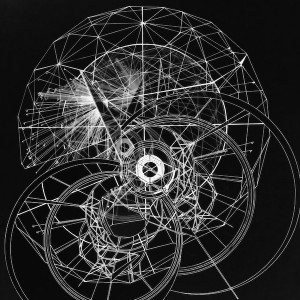
Laboria Cuboniks is currently a group of 6 women working together online to redefine a feminism adequate to the twenty-first century. They collectively wrote Xenofeminsim: A Politics for Alienation in 2014. Here, in conversation with Postcontemporary Issue guest editors Armen Avanessian and Suhail Malik they discuss the dissatisfactions and limitations of historical feminism and the importance of theorizing “the future” as a feminist project. Armen Avanessian and Suhail Malik: The initial formulation of your political… [read more »]

Letters from the Ocean Terminus David Roden Letters from the Ocean Terminus is a series of overlapping fragments from disruptive futures; a theory-fiction that explores routes out of the present as aberrant transformations and terraforming desires. Pavement rushing at us, lit by headlights. Beyond, darkness. SARAH (V.O.) The future, always so clear to me, has become like a black highway at night. We were in uncharted territory now… making up history as we went along.1… [read more »]

Aihwa Ong, interviewed by Armen Avanessian and Suhail Malik Constructing Globality Armen Avanessian and Suhail Malik: Your anthropological research pays close attention to specific emerging and inventive configurations of globally-constituted modernization, particularly in East Asia and its diaspora. Throughout this work you identity many ways in which ‘things that used to be fused together — identity, entitlement, territoriality, and nationality — are being taken apart and realigned in innovative relationships and spaces by neoliberal technologies… [read more »]

Fractured Mediations Victoria Ivanova Once a poster image for the great promise of universal accountability, the human rights system is now perhaps most infamous for its institutional failures.1 And yet, its most intriguing shortcomings are to be found in the ways it has failed to cohere with our times as a mediation regime rather than simply as a defunct juridico-institutional project.2 That is, human rights have lost their traction as a means of framing the… [read more »]

Introduction to The Time Complex. Postcontemporary The systems and infrastructures of large-scale societies typical of globalisation scramble the conventional order of time, in which the future will succeed a present that has succeeded the past. The post-contemporary present instead transmits a future that has already taken place and it is the unknown future of the past that it exceeds. This is the time signature of our global condition. It is the time-complex. A DIS Issue… [read more »]
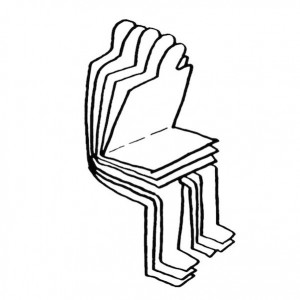
The Time-Complex. Postcontemporary A conversation between Armen Avanessian and Suhail Malik Time is changing. Human agency and experience lose their primacy in the complexity and scale of social organization today. The leading actors are instead complex systems, infrastructures and networks in which the future replaces the present as the structuring condition of time. As the political Left and Right struggle to deal with this new situation, we are increasingly wholly pre-empted and post-everything. Time Arrives… [read more »]
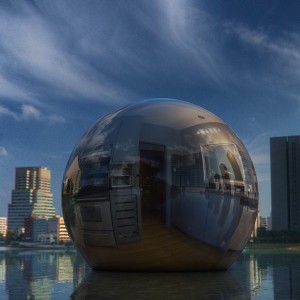
On Speculative Design Benjamin H. Bratton Benjamin Bratton on Speculative Design, an alternative to mainstream Design that complicates the speculative models that underscore our global economy. He suggests design solutions based on longer and shorter timescales than regular product lifecycles, and geared toward “users” who may or may not be human. This text is based on a transcription of Bratton’s remarks at the launch of the Speculative Design undergraduate major at the University of California,… [read more »]

Hayley Silverman’s “Dog Plays,” an ongoing series in which a cast of untrained dogs take on the role of characters from a range of pop-culture texts, disrupt the canon of identities traditionally represented in Hollywood as they are re-inhabited by animals. Calling on artifacts ranging from Richard Linklater films, to science-fiction thrillers, to Depression-era musicals that rhapsodize class difference, these performances investigate how our understanding of narrative, authority and identity transforms when we project stories,… [read more »]
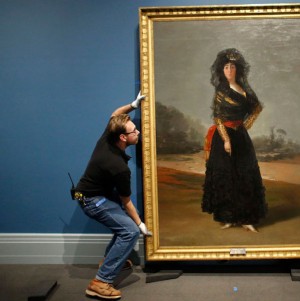
Art and Capital Olav Velthuis in conversation with Sarah Lookofsky The art market is not actually booming. Sociologist Olav Velthuis puts the artworld’s economic misconceptions to bed with Sarah Lookofsky. Sarah Lookofsky: Olav, you have argued that the popularly cited art market “boom” is overstated. In your analysis you describe instead a “winner-take-all” boom that only affects top players: a dramatic rise in money exchanged by the highest collectors concerning the work of very few… [read more »]

